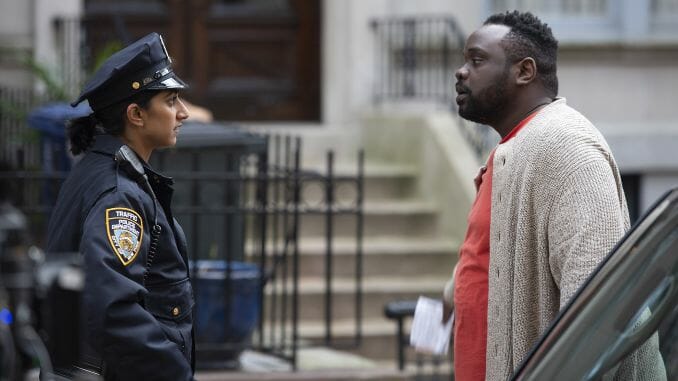The Underexamined Anxieties of The Outside Story Raise More Questions than Answers

The keen sting of life’s myriad inconveniences can be harrowing. There are those moments of anticipation, like after you stub a toe and know a wave of concentrated pain is on its way. There’s the vague discomfort of realizing you’ve forgotten something but are unable to recall what that something is. Then there’s the feeling of being locked out. It’s a specific inconvenience endured by people who are privileged enough to be reliably housed but an annoyance nonetheless, because everything you know and need is on the other side of a door that you cannot reenter. There are ways in which the inconvenience of being locked out can be heightened as a Black person in a nice neighborhood—ways in which your presence may stoke existential fears and induce significant personal anxiety. How is the precariousness of this situation to be elegantly rendered on film in a way that honors the reality of these anxieties without steeping a ubiquitous headache (being locked out) in trauma so it can be read as authentically capital-B Black?
This question is posed in writer/director Casimir Nozkowski’s semi-autobiographical debut feature The Outside Story, but a wholehearted attempt at an answer is not provided. In the film, we meet Charles Young (Brian Tyree Henry), a Brooklynite documentarian who gets locked out of his apartment on a day when his recent breakup already has him in the depths of despair. While waiting for his landlord to arrive, Charles—shoeless, walletless and with a dying phone—deliberately engages with his neighbors for effectively the first time. He helps a pregnant woman having a stoop sale, befriends a fledgling piano prodigy with an abusive mother, helps an elderly woman set up a dating profile and invokes the aid of the polyamorous couple upstairs. Through it all, Charles dodges harassment from Slater (Sunita Mani), the neighborhood meter maid.
The dichotomy between inside and outside is explored dualistically in The Outside Story, through the fact that Charles is locked out (of course), but also through how his homebody tendencies were a partial impetus for his split with ex-partner Isha (Sonequa Martin-Green). His accidental expulsion to the outside world is a cosmic push out of his mopey hidey-hole. This return to the outside unsurprisingly holds specific resonance in the wake of a slightly re-opening, still pandemic-stricken America. While Nozkowski’s film contains heartwarming meditations on the importance of connection and forgiveness, the filmmaker stumbles in adapting the nuances of his personal inconvenience to the film’s Black lead. Though it was refreshing to see a Black male protagonist and his Black ex-partner manage the pain of something as quotidian as a recent separation—rather than that oh-so-quintessential Black trauma—the social specificity of being locked out as a Black person who lives in a ritzy Brooklyn brownstone is never confidently addressed.
It’s difficult to gauge if the ways Charles’ Blackness colors the personal obstacles of the day remains under-addressed so as to be deliberately subtle, not overpowering the other elements of the film, or if Nozkowski was afraid to go there and thereby used subtly to mask what may have been afterthoughts. During an opening sequence, Charles orders food. When the Black delivery guy (Jordan Carlos) complains about not receiving a tip, he asks Charles, “I don’t make a living wage. How can you afford to live here, sir?”
I was intrigued by the inclusion of this question early in the film. Perhaps it would foreshadow some intentional exploration of the politics of being locked out and Black in Brooklyn. But this question, posed in the first 10 minutes, is never overtly explored. Charles does not confide in a single person about what this situation looks like or how that makes him feel. Rather, he talks about the inconvenience of the day and not the genuine threat and existential panic this might induce for a Black man in his position. Therein lies a missed opportunity, an element of authenticity that isn’t quite imbued into his character.